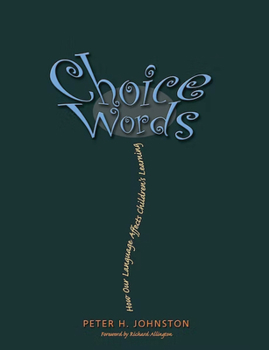Choice Words: How Our Language Affects Children's Learning
Select Format
Select Condition 
Book Overview
In productive classrooms, teachers don't just teach students math and reading skills; they build emotionally and relationally healthy learning communities. Teachers create intellectual environments that produce not only technically competent students, but also caring, secure, actively literate human beings. Choice Words: How Our Language Affects Children's Learning shows how teachers can accomplish this by using their most powerful teaching tool:...
Format:Paperback
Language:English
ISBN:1571103899
ISBN13:9781571103895
Release Date:May 2004
Publisher:Routledge
Length:118 Pages
Weight:0.40 lbs.
Dimensions:0.3" x 6.1" x 9.0"
Customer Reviews
5 ratings
Choice Words: How our Language Affects Children's Learning
Published by Thriftbooks.com User , 15 years ago
We are using this book as a book study group in our elementary school It serves as a great springboard for conversation about teaching strategies and learning. The book provides insights to new teachers as well as seasoned teachers and can serve as a way to share and reflect as a learning and teaching community.
Choice Words: How Our Language Affects Children's Learning
Published by Thriftbooks.com User , 16 years ago
This book really changed my thinking about how to speak to children to promote the best learning, and what to say. Our words are powerful tools in the 'teacher's took kit' and must be used with care.
An amazing small, yet powerful book.
Published by Thriftbooks.com User , 17 years ago
I couldn't put it down--which is often said of a novel, but maybe not so often about a professional book. I truly read the book for six hours, and only took a few breaks. I started out highlighting what I found provocative, but soon realized that that wasn't enough. I got out my post-its, and began to note bits of wisdom I didn't want to forget. I think I must have added 50 post-its!! It's not that the information is so new, but rather that it is such a reminder and "emphasizer" about how we talk to children, and treat them in our classrooms. I thank Mr. Johnston for his thoughtful approach, and love the organization of the book. I've shared bits and pieces of what I've read with the staff at my school, and plan to continue to do so for the rest of the year. I've ordered two more copies of the book to share with colleagues. Thank you for this inspiring book.
Choice Words: How our Language Affects Children's Learning
Published by Thriftbooks.com User , 17 years ago
Tho' many of the things Peter Johnston says in the book, I already know, it was good to review and it got me to thinking about how I come across to my students and how I can BETTER get them to do their own thinking and inquiring by the language (questioning) I use with them. It is a concise book and one that I'm sure I'll be referring to many times in the future.
A must read for busy teachers seeking quality change
Published by Thriftbooks.com User , 19 years ago
Peter Johnston's new book Choice Words - How Our Language Affects Children's Learning grew out of his work with exemplary teachers. For the past decade, Johnston and his colleagues have observed, interviewed, and reported on what makes an effective teacher. A key aspect of his research centers on the language teachers use in the classroom with their students. This thin, teacher-friendly volume is filled with excerpts from real classrooms and gives the reader a sense of eavesdropping on some of the best instruction in the country. Johnston turns the traditional idea of teacher as keeper-of-information on its head and invites the reader to consider the alternatives. Through a classroom community of social justice and democracy, children learn to question themselves and build agency as they emerge into the literate world. Johnston's goal is to build a sense of agency within each student that ultimately adds to the larger classroom community. This idea of agency involves a child's sense of himself and his abilities. By developing the child's personal narrative of success, rehearsed frequently as a self-reminder and teaching tool for classmates, the teacher equips him with a knowledge and self-awareness that feeds on itself. The child becomes confident when new problems appear and moves through familiar steps of problem solving. Questions like "How did you figure that out?" and "What problems did you come across today?" underscore the idea that problems are not failures, but rather normal occurrences that can be overcome by using certain strategies. In addition to building these powerful narratives, teachers can reflect a child's knowledge through questions that solicit thorough explanations for what is known and draw connections between ideas. Questions like "How did you know that?", "How else . . . ?" and "How could we check?" enable students to articulate what they know and construct deeper meaning. Trust me, it's a good one!





